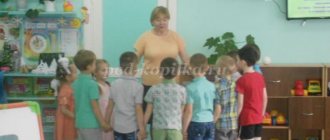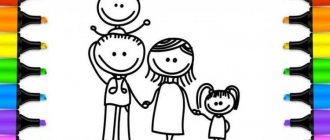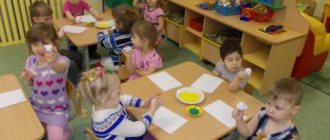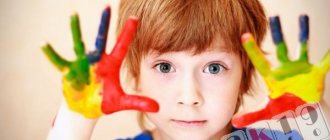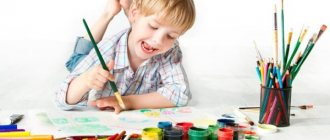Large plate with different fruits
Having learned to draw individual fruits, you can begin to arrange them, and a still life image would be an excellent solution. To make drawing easier, all objects can be placed on a large plate, which can be easily redrawn from a picture or used as a photo base:
- a plate is depicted on the piece of paper; to do this, you need to draw a semicircle; it doesn’t have to be closed, leaving space to place all the selected fruits and vegetables;
- in the foreground it is best to depict simple and quickly recognizable figures, these can be apples and pears, they can be placed horizontally and vertically;
- fruits such as plums will decorate the composition and add additional colors to the resulting picture, but it is best to complement the image with small details;
- A purple bunch of grapes will look beautiful on a plate; for this, a pile of small circles covered with an openwork green leaf is drawn behind the apples;
- all the berries must be carefully outlined and painted in a lighter shade than the outline, so the berries will not merge into one lump of color and will be clearly visible in the drawing;
- It’s very easy to draw a green grape leaf; a maple leaf template is suitable for this, only the edges of such a sketch need to be drawn with openwork lines;
- Place several cherries along the edge of the plate; to do this, two circles with a concave top are connected with a green L-shaped pin;
- It is also better to draw single cherries with petioles, this will make it possible to quickly recognize them in the picture and draw it with small details, which will emphasize the naturalism of the picture;
- The final stage of drawing will be coloring the picture; having saturated it with colors, you can begin to decorate the background; it is best to choose calm and shallow shades for it.
Using watercolor paints, it is easy to turn the resulting drawing into a real masterpiece and, after drying, place it in a frame and under glass. These paints help to paint individual fruits to imitate their real color with different shades and natural chiaroscuro reflecting the depth of color.
Simple master classes will help you learn fruit drawing techniques, which will be useful for creative activities with children of different ages. Even if children are not interested in creative lessons, they can be used to learn shapes and colors, the names of new fruits and even vegetables.
Rules for beginners
There are several basic rules for depicting objects, the observance of which will help you quickly master drawing techniques. They are simple and often guessed intuitively.
Rule for the relative arrangement of objects
Objects of the same size placed in a row look boring and do not create perspective. The picture will look three-dimensional, harmonious and beautiful if the objects on it partially overlap each other or there is a small distance between them.
A still life that combines these two types of arrangement of drawing elements looks even more interesting. This allows you to create a feeling of volume and depth: in the picture, some elements partially overlap others or are located at a distance.
The most advantageous is the triangular arrangement of objects. The vertex of a triangle is the highest point of the tallest object, and the elements of lower height form its base. There are also horizontal and circular ways of arranging still life elements.
Color selection rule
A wide variety of colors will make the design variegated and irritating to the eye, so usually 2-3 primary colors and their shades are chosen.
If there are a lot of fruits, and they all differ in color, then one of the colors becomes dominant, and the rest should complement it.
Composition center rule
In a still life, one of the objects should be the focus of attention, stand out sharply in color, size, shape, and position, attracting the attention of the beholder. When composing a composition, you need to determine this object in advance and place it in the center of the composition
Rule of proportions
It is not necessary that all the fruits and other objects in the drawing be depicted in life-size, but it is necessary to maintain the ratio of sizes, otherwise the drawing will look unnatural.
Rule of Perspective
Closer objects are located below, are larger in size and are drawn in more detail. Objects that are further away are placed higher on the sheet and are partially overlapped by other, closer objects. They are drawn in a few strokes, without detail. This allows you to create the impression of volume.
Shadow Rule
The shadows of all objects must be directed in the same direction, otherwise the drawing will not look realistic. Objects and parts of objects that are in the shadow have a darker color, and those that are well lit have a lighter color.
To create a shine effect, it is enough to leave a section of the surface of the object unpainted, having previously determined exactly where it should be located relative to the imaginary light source. Shadows and highlights create a feeling of volume and a shiny surface.
Layout rule on the sheet
The drawing will look good if it occupies the middle of the sheet, leaving a small clear space on the sides, top and bottom, and less space is always left at the bottom than at the top. This creates the illusion that the depicted objects are standing on some surface.
Large plate with different fruits
Having learned to draw individual fruits, you can begin to arrange them, and depicting a still life will be an excellent solution. To make drawing easier, all objects can be placed on a large plate, which can be easily redrawn from an image or used as a basis for a photo:
- a dish is depicted on the sheet, for this you need to draw a semicircle, you cannot close it, leaving space for placing all the selected vegetables and fruits;
- We place several cherries on the edge of the plate; to do this, use a green L-shaped pin to connect two circles with a concave top;
- all berries must be carefully outlined and painted with a lighter shade of the outline so that the berries do not merge into a single color and are clearly visible in the image;
- in the foreground it is better to depict simple and quickly recognizable figures, these can be apples and pears, they can be placed horizontally and vertically;
- A bunch of purple grapes will look beautiful on a plate; for this, a pile of small circles covered with an openwork green leaf is drawn behind the apples;
- The final stage of the drawing will be coloring the picture, having saturated it with colors, you can start decorating the wallpaper, it is better to choose calm and shallow shades.
- It is also better to draw individual cherries with petioles, this will allow you to quickly recognize them in the image and draw them in small details, which will emphasize the naturalness of the image;
- It’s very simple to draw a green grape leaf, a maple leaf pattern is suitable for this, only the edges of such a sketch need to be drawn with openwork lines;
- they will decorate the composition and add additional colors to the resulting image, such as fruits, for example, plums, but it is better to complement the image with small details;
Using watercolors, you can easily turn the resulting drawing into a real masterpiece and, after drying, place it in a frame and under glass. These paints help color individual fruits by imitating their true color with varying shades and natural highlights and shadows that reflect the depth of color.
Simple master classes will help you master the technique of drawing fruits, which will be useful for creative activities with children of different ages. Although creative lessons do not excite children, they can be used to learn shapes and colors, the names of new fruits and even vegetables.
